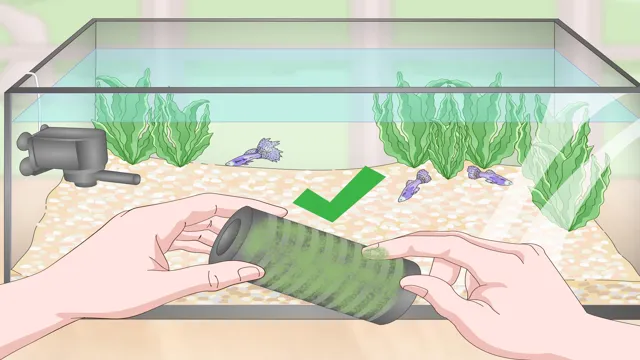How to Raise pH in Aquarium: 5 Effective Ways to Improve Water Chemistry

Is the low pH level in your aquarium causing your fish to lose their color and vitality? Maintaining the right pH level in your aquarium is crucial for ensuring the optimal health and well-being of your aquatic pets. A low pH level can lead to harmful bacteria and toxins, leading to diseases and even death in your fish. But don’t worry, increasing the pH level in your aquarium is a simple process that can be done with a few tweaks here and there.
In this blog, we will guide you through the steps to increase the pH level in your aquarium and keep your aquatic pets happy and healthy. So, let’s dive right in!
Understanding pH Levels
If you’re looking to raise the pH level in your aquarium, there are a few ways you can go about it. One option is to add pH-increasing products, such as baking soda or calcium carbonate, to the water gradually over the course of a few days or weeks. Another method is to use limestone, crushed coral, or a similar substance as a substrate in the aquarium.
These materials will slowly release minerals that raise the pH level. Whatever method you choose, it’s important to monitor the pH level regularly with a test kit to make sure it remains within a healthy range for your fish and plants. Remember to start slowly and make gradual changes, as sudden shifts in pH can stress and even kill your aquatic inhabitants.
What is pH?
pH levels pH is a measure of acidity or alkalinity on a scale of 0 to 1 A pH of 7 is considered neutral, while anything below is acidic and anything above is alkaline. Understanding pH levels is important for many reasons, including agriculture, manufacturing, and even our own bodies.
For example, plants need a specific pH range to absorb nutrients from the soil, while certain materials may require a certain pH level to maintain their quality. In the human body, the pH of our blood needs to be tightly regulated at around 4, as any deviation can cause serious problems.
pH can be measured using litmus paper or electronic devices, and it’s important to maintain the correct levels in a variety of settings. So, next time you hear someone mention pH, you’ll know that it’s all about balancing acidity and alkalinity for optimal health and functionality.

Why is pH important in aquariums?
pH levels, aquariums, importance Maintaining proper pH levels is crucial for keeping fish and other aquatic creatures healthy and thriving in aquariums. pH is a measure of the acidity or alkalinity of water and can range from 0 to 1 The ideal pH level for most aquarium species is between
5 and Fluctuations in pH can lead to stress, illness, and even death in fish.
Low pH levels can cause a buildup of harmful toxins, while high pH levels can inhibit the intake of essential nutrients. It is essential to test the pH levels regularly and adjust them as needed with the use of pH buffers or water treatments. A stable pH level will ensure that your aquatic pets remain healthy and happy in their environment.
Remember that a healthy pH balance is like maintaining a balanced diet for humans, it’s crucial to keep everything in harmony to thrive and enjoy life.
Normal pH range for aquariums
The pH level is one of the most important parameters when it comes to maintaining a healthy aquarium environment. The normal pH range for aquariums is typically between 0 and
0, with 0 being considered neutral. pH is measured on a logarithmic scale, meaning that every one-point difference represents a ten-fold change in acidity or alkalinity.
In other words, a pH of 0 is ten times more acidic than a pH of 0.
It is essential to monitor and adjust the pH levels regularly to ensure the health and well-being of your fish and plant life. Rapid changes in pH can be harmful to aquarium inhabitants, so it’s always best to make gradual adjustments. Keeping your aquarium within the normal pH range will help promote healthy bacteria growth, keep your fish active and thriving, and ensure that your plants absorb necessary nutrients.
Remember, different species of fish prefer different pH levels, so research your specific fish’s optimal pH range before making any adjustments. With consistent monitoring and care, maintaining a healthy pH level in your aquarium is easy and rewarding!
Causes of Low pH
If you’re having trouble maintaining the pH level in your aquarium, there are a few common causes that could be at play. One of the most common reasons for low pH is a buildup of carbon dioxide in the water. This can happen if the aquarium is overstocked with fish or if there is poor water circulation.
Another potential cause of low pH is a lack of buffering agents in the water. These agents help prevent rapid changes in pH, but without them, the water can become more acidic over time. One way to solve this issue is to add a buffer to the water, such as crushed coral or limestone.
Other factors, like the type of substrate in your aquarium or the source of your water supply, can also affect pH levels. Regardless of the cause, it’s important to keep a close eye on your aquarium’s pH and take action if necessary to maintain a stable and healthy environment for your aquatic pets. To higher pH in aquarium, you can use a pH buffer like baking soda or a commercial product designed specifically for aquariums.
Additionally, you can perform regular water changes to help dilute acids and maintain a stable pH.
Too much CO2
As carbon dioxide levels continue to rise in the atmosphere, one of the major consequences is ocean acidification, resulting in a lowered pH. This is because when carbon dioxide is absorbed into seawater, it reacts with water molecules, producing carbonic acid. This reaction ultimately leads to the water becoming more acidic, meaning its pH drops.
Other factors such as nutrient runoffs from land, industrial processes, and waste discharge contribute to increased CO2 levels. As the ocean becomes more acidic, it has significant impacts on marine ecosystems, including the ability of marine organisms to build shells, corals to calcify, and overall food web dynamics. The solution to this problem requires action on a global scale, reducing our carbon footprint, and focusing on sustainable practices to create a healthier planet.
Lack of oxygen
Lack of oxygen can be one of the primary causes of low pH. Oxygen is essential for the well-being of aquatic life, and when oxygen levels are low, pH levels can drop significantly. This can happen due to various reasons such as excessive algae growth, high temperatures, and chemical imbalances.
When algae grow exponentially, they consume large amounts of dissolved oxygen, leaving little to no oxygen for other aquatic organisms. Similarly, high temperatures can reduce the solubility of oxygen in water, leading to low dissolved oxygen levels. Furthermore, chemical imbalances caused by the discharge of industrial waste or excessive use of fertilizers can also contribute to the depletion of oxygen levels.
All of these can cause fish kills, damage to the ecosystem, and even human health problems. Therefore, it is essential to keep these factors under control to maintain an ideal, healthy aquatic environment.
Presence of acids
When it comes to our skin, pH levels matter. The pH level is a measure of how acidic or alkaline something is, and when it comes to our skin, a slightly acidic pH is ideal. However, many factors can cause our skin’s pH to become too low or too high.
One such factor is the presence of acids. Acids can be found in many skincare products, such as toners and exfoliators. While these products can be beneficial for our skin when used in moderation, overuse can disrupt the skin’s natural pH balance and cause irritation and dryness.
Additionally, environmental factors such as pollution and hard water can also contribute to acidic skin. To combat this, it’s essential to choose skincare products with a balanced pH level and to limit the use of products with harsh acids. By taking care of our skin’s pH levels, we can achieve healthy, glowing skin.
Poor quality substrate
One of the reasons why the pH of your substrate may be low is due to poor quality substrate. This happens when the soil mix lacks the necessary nutrients to maintain a balanced pH level, which leads to acidity. The soil may also contain contaminants that can damage the pH levels of the substrate.
Poor quality substrate can affect the health of your plants, making them more susceptible to diseases and pests. To avoid this, it is important to ensure that the soil mix you use is of high quality and contains the right ratio of nutrients. You should also test the pH levels of your substrate regularly to catch any imbalances early and take corrective measures as needed.
Remember, a healthy substrate leads to healthy plants.
Methods to Increase pH
If you are struggling with low pH levels in your aquarium, don’t worry, there are various methods you can utilize to increase the pH levels. One way is to perform partial water changes. This method involves changing about 10-20% of the aquarium water every week, which can help remove acidic substances and bring up the pH levels.
Another way is to add crushed coral or limestone to your aquarium substrate, which will slowly dissolve and release calcium carbonate, raising the pH levels. Additionally, you can add baking soda to your aquarium in small amounts, but be careful not to add too much at once. Remember, it is essential to monitor the pH levels regularly to ensure that they are stable and safe for your aquatic plants and animals.
By using these methods, you can maintain healthy pH levels in your aquarium.
Add baking soda
If you are looking for ways to increase the pH level of your baking mixture, adding baking soda is an effective method. Baking soda is a basic compound that will raise the pH level of the mixture, making it less acidic. You can add a small amount of baking soda to your dough or batter to increase the pH level gradually.
It is essential to measure the amount of baking soda you add to avoid over-alkalinity and affect the taste of your final product. You can also use baking soda to reduce the acidity of acidic ingredients such as buttermilk or lemon juice. Just remember that adding too much baking soda can lead to an undesirable taste and texture, so always use it in moderation.
Adding baking soda is an easy and reliable way to increase the pH level of your baking mixture and improve the quality of your final product.
Use a commercial buffer solution
If you need to increase the pH of something, one method you can utilize is by using a commercial buffer solution. Buffer solutions are designed to resist changes in pH and can be an effective way to stabilize the pH of a solution. Commercial buffer solutions can come in a variety of pH ranges, so it’s important to choose the one that matches the pH level you need.
When using a buffer solution, it’s important to follow the manufacturer’s instructions carefully to ensure that you are achieving the desired pH level. While it may be tempting to try DIY solutions to increase pH, using a commercial buffer solution can be a more reliable and precise method.
Add limestone or crushed coral
If you’re struggling to maintain a consistent pH level in your aquarium, adding limestone or crushed coral can be a simple and effective solution. Limestone and crushed coral are both composed of calcium carbonate, which raises the pH level of water as it dissolves. By adding these substances to your aquarium, you can help keep the pH level stable and within the appropriate range for your fish and plants to thrive.
However, it’s important to gradually introduce these substances over time to avoid sudden shifts in pH that could stress or harm your aquatic life. Monitor the pH level regularly and adjust the amount of limestone or crushed coral accordingly for best results. With a little bit of patience and attention to detail, you can create a healthy and balanced environment for your aquarium inhabitants.
Aerate the water
One of the methods to increase pH in your aquarium is to aerate the water. Aeration is the process of adding oxygen to the water, which can help increase the pH level by reducing carbon dioxide and other acidic compounds. You can do this by using an air pump and air stone, which release small bubbles into the water, creating movement that helps distribute oxygen throughout the aquarium.
Another option is to use a powerhead or filter with a spray bar attachment, which can create surface agitation and help with oxygen diffusion. It’s important to monitor the pH levels regularly and adjust as necessary, keeping in mind that sudden changes can be stressful for your fish. By aerating the water and maintaining proper pH levels, you can help ensure a healthy and thriving aquarium environment for your aquatic friends.
Precautions to Take
Raising the pH levels in your aquarium can be a delicate task and requires certain precautions to be taken. First and foremost, it’s important to test your aquarium’s water regularly to ensure that you’re not making any sudden changes that could harm your fish or plants. It’s also essential to avoid rapid pH changes, as this can cause shock to your aquatic pets.
Instead, try to make gradual adjustments to the pH levels over several days or weeks. Another precaution to take is to avoid adding too many fish to your aquarium all at once. A crowded aquarium can lead to increased waste buildup, which can impact the pH levels negatively.
Finally, always make sure to add any pH-affecting materials, such as rocks or substrate, slowly and carefully so as not to upset the delicate balance of your aquarium’s environment. By taking these precautions, you can safely and effectively adjust the pH levels in your aquarium and maintain a healthy, thriving aquatic community.
Test pH regularly
If you want to maintain an optimal balance in your pool or aquarium, it’s essential to regularly test the pH levels and take necessary precautions accordingly. Neglecting this aspect may lead to various issues like algae buildup, corrosion of equipment, and skin irritation to people who use the pool. The ideal pH level for most pools is between
2 to 8, while for aquariums, it ranges between 5 to
5, depending on the fish species inhabiting it. It is essential to keep in mind that extreme changes in pH levels can also cause stress to the aquatic life, and they may even die. Testing pH levels is a simple process that you can accomplish using test kits or electronic pH meters readily available in the market.
Ensure you follow the instructions carefully to obtain accurate results. It’s best to avoid pH level fluctuations as much as possible since it can lead to problems. To do this, you can add basic chemicals like soda ash if the pH level drops, or acid if the pH level increases.
Ultimately, the key to maintaining a healthy aquatic environment is to consistently monitor pH levels and take necessary steps to ensure it remains within the optimal range.
Add buffers slowly
When it comes to adding buffers to your aquarium, it’s important to take certain precautions. One of the most important things to keep in mind is to add buffers slowly. This means that you should add small amounts of buffer over time instead of adding a large amount all at once.
This method will help prevent any sudden changes in pH levels, which can be harmful to your fish and aquatic plants. Additionally, it’s important to test the pH levels frequently and make adjustments accordingly. By following these precautions, you can ensure that your aquarium maintains a balanced pH level and creates a healthy environment for your aquatic inhabitants.
Remember, slow and steady wins the race!
Avoid sudden changes in pH
When it comes to maintaining the pH of your water, sudden changes can spell disaster. It’s important to take precautions to ensure your water’s pH level remains stable to avoid harming your aquatic pets or plants. One way to do this is to regularly test and monitor your water’s pH levels.
This will allow you to make gradual changes if needed instead of sudden, drastic ones. Another precaution to take is to avoid using drastic measures such as adding too much acid or alkaline substances to your water. These sudden changes can harm your pets or plants, and even cause sudden death.
Think of it like this: if you were suddenly thrown into freezing cold water or boiling hot water, it would be a shock to your system, right? It’s the same for aquatic life – gradual changes are easier to adapt to than sudden ones. So, take care when it comes to pH levels in your water and make sure to avoid sudden changes for the health and safety of your aquatic pets and plants.
Monitor the impact on other aquarium factors
When setting up a new aquarium or adding new fish or plants, it’s important to monitor the impact on other aquarium factors. This includes things like water pH, temperature, and filtration. One major precaution to take is to avoid overcrowding the tank, as this can lead to stress and disease in the fish.
It’s also important to regularly test the water quality and make adjustments as needed, such as adding additional filtration or adjusting the pH with chemicals or natural means. Keep an eye on the behavior of the fish, as they can often indicate when something is wrong in the tank. By taking these precautions and monitoring the impact on other factors, you can help ensure a healthy and thriving aquarium for years to come.
Remember, the well-being of your fish should always be the priority in any aquarium setup or maintenance.
Conclusion
In conclusion, raising the pH of your aquarium can be a daunting task, but with the right tools and knowledge, it can be a walk in the park. To achieve a higher pH level, remember to regularly perform water changes, test often, and add appropriate buffering agents as needed. Don’t forget, a happy and healthy aquarium requires a delicate balance of many factors, so always strive to maintain a holistic approach.
So go forth, aquarium enthusiast, and may your pH be forever in your favor!”
FAQs
What is the ideal pH level for an aquarium?
The ideal pH level for most aquarium fish is between 6.5 and 7.5.
How do I test the pH level of my aquarium water?
You can use a pH test kit to measure the pH level of your aquarium water.
What causes a low pH level in an aquarium?
A low pH level in an aquarium can be caused by factors such as high levels of CO2, lack of aeration, or high levels of organic waste.
How can I safely raise the pH level in my aquarium?
You can raise the pH level in your aquarium by adding a pH increaser or by using natural methods such as adding crushed coral or limestone.
Can a high pH level harm my fish?
Yes, a high pH level can harm your fish and lead to health issues such as stress, disease, and even death.
How often should I test the pH level in my aquarium?
It is recommended to test the pH level in your aquarium at least once a week to ensure a healthy environment for your fish.
What other factors besides pH level should I consider for a healthy aquarium?
Other factors to consider for a healthy aquarium include proper filtration, regular water changes, appropriate water temperature, and suitable tank mates for your fish.






